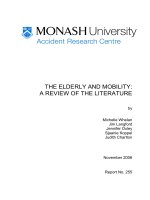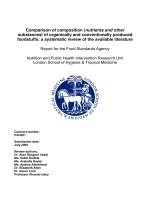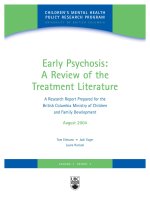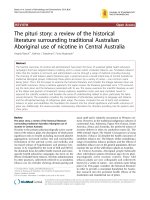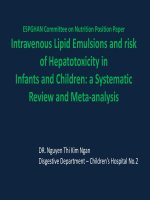Retractile testes: A review of the current literature | Website Bệnh viện nhi đồng 2 - www.benhviennhi.org.vn
Bạn đang xem bản rút gọn của tài liệu. Xem và tải ngay bản đầy đủ của tài liệu tại đây (151.48 KB, 15 trang )
RETRACTILE TESTES
A review of the current literature
UROLOGY DEPARTMENT
CHILDREN’S HOSPITAL NO.2
Definitions
Normal size
Intermittently resides in the groin
Testes that can be brought down into their normal position in the
scrotum
Remains there for a period
Aetiology
Variant of normal
Strong scremasteric reflex
Taut spermatic cord in a testis which is in the process of ascending
Clinical examination
Supine
Manipulate the testis to the base of the scrotum
Release to observe whether it remains there or moves back up into
the groin
OUTCOME OF RETRACTILE TESTES
Acquired undescended testes
Acute torsion
Reduced fertility
Tumour risk
Acquired undescended testes
La Scala & Ein reviewed 150 boys with 205 retractile testes with a 7year follow-up period 23% of retractile testes eventually becoming
an acquired UDT [1]
Agarwal et al. a cohort of 122 boys with 204 retractile testes over 8
years of follow-up: 32% of retractile testes eventually becoming
acquired UDT [2]
cord tautness as a risk for ascent
Stec et al. looked at the outcome of 172 boys with 274 retractile
testes over a follow-up period of 26 months 7% acquired UDT [3]
Limited: definition, indication of orchidopexy, short follow-up periods
Acute torsion
Only an isolated case report of this within the literature (Charles JC.
The fate of the retractile testis. J Urol 2004;171:1237) [4]
Retractile testes are no increased risk for acute torsion over normal
testes
Tumour risk
Congenital UDT have an increased relative risk of germ cell
malignancy that may be approximately 5-10 times [5]
Acquired UDT do not have an increased risk of malignancy [6]
retractile testis per se is not at an increased relative risk of
developing a cancer
Reduced fertility
Caucci et al. sperm counts in semen of 38 young male adults treated for
retractile testes before puberty and 7 adults with retractile testes
normal semen analysis: 21% in young adults with previously treated retractile
testes, 29% in adults with retractile testes
retractile testes with reduced size are a risk factor for male infertility [9]
Other epidemiological studies of infertile adult males have identified
retractile testes as being associated with lower sperm counts and
hypospermatogenesis on biopsy[10-12]
increase in testicular temperature resulting in impaired spermatogenesis [12]
Reduced fertility
Puri and Nixon assessed paternity rates in 43 adult males who as
children had bilateral retractile testes: 74% of the subjects had
fathered children and that testicular volumes were normal
retractile testes develop normally with no harmful effects on fertility
[13]
Dadfar MR performed orchidopexies on 22 adult males with idiopathic
infertility and bilateral retractile testes, and measured their
testicular volumes and sperm parameters after 1 year: no change in
testicular volume and sperm density, but improved sperm motility [14]
Limited: not established paternity, not performed semen analysis
Conclusion
Retractile testis may become an ascended testis: Level 4 evidence
Acute torsion: no evidence
Tumour risk: no evidence
Reduced fertility: poor evidence
Not enough evidence to warrant orchidopexy on a retractile testis
But recommend annual clinical surveillance of retractile testes until
beyond puberty
And reserve orchidopexy for testes which can no longer be brought
down into the scrotum (ascended testes)
Thank for your attention!
References
[1] La Scala GC, Ein SH. Retractile testes: an outcome analysis on 150 patients. J
Pediatr Surg 2004;39:1014e7.
[2] Agarwal PK, Diaz M, Elder JS. Retractile testis -is it really a normal variant? J
Urol 2006;175:1496e9.
[3] Stec AA, Thomas JC, DeMarco RT, Pope JC, Brock JW, Adams MC. Incidence
of testicular ascent in boys with retractile testes. J Urol 2007;178:1722e5.
[4] Charles JC. The fate of the retractile testis. J Urol 2004;171:1237.
[5] Garner MJ, Turner MC, Ghadirian P, Krewki D. Epidemiology of testicular
cancer: an overview. Int J Cancer 2005;116:331e9.
[6] Ong C, Hasthorpe S, Hutson J. Germ cell development in the descended and
cryptorchid testis and the effect of hormonal manipulation. Pediatr Surg Int
2005;21:240e54
References
[7] Ito H, Kataumi Z, Yanagi S, Kawamura K, Sumiya H, Fuse H, et al. Changes in
the volume and histology of retractile testes in prepubertal boys. Int J Androl
1986;9:161e9.
[8] Han SW, Lee T, Kim JH, Choi SK, Cho NH, Han JY. Pathological difference
between retractile and cryptorchid testes. J Urol 1999;162:878e80.
[9] Caucci M, Barbatelli G, Cinti S. The retractile testis can be a cause of adult
infertility. Fertil Steril 1997;68:1051e8.
[10] Caroppo E, Niederberger C, Elhanbly S, Schoor R, Ross L, D’Amato G. Effect
of cryptorchidism and retractile testes on male factor infertility: a multicenter,
retrospective, chart review. Fertil Steril 2005;83:1581e4.
[11] Abyholm T, Oian P, Gordeladze JO. True cryptorchidism and retractile testes in
infertile men. Acta Eur Fertil 1986;17:15e8.
[12] Mieusset R, Bujan L, Massat G, Mansat A, Pontonnier F. Clinical and biological
characteristics of infertile men with a history ofcryptorchidism. Hum Reprod
1995;10:613e9
References
[13] Puri P, Nixon HH. Bilateral retractile testes- subsequent effects on fertility. J
Pediatr Surg 1977;12:563e6
[14] Dadfar MR. Orchidopexy for retractile testes in infertile men. A prospective
clinical study. Urol J 2007;4:164e8.
